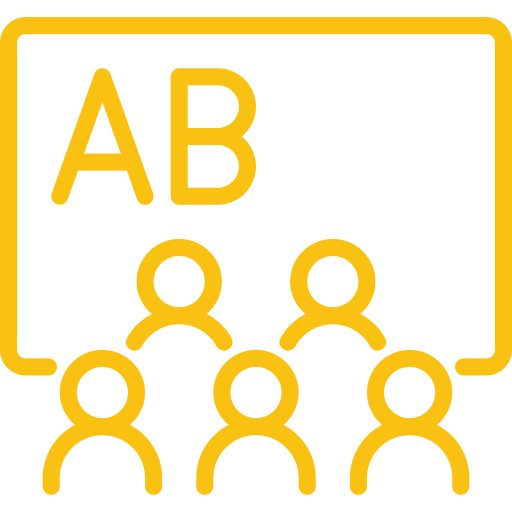1 in 4. And the numbers are growing rapidly.
Often these young learners are identified as lower-level students, or in some cases deficient. These students often have the same abilities, they just need a little help jumping over the extra hurdles that come with speaking a second language.
And the second language for many of those kids is English, not their other language. Many of them are translating conversations at parent/teacher night. They may be the first person in their family to go to school in the US.
These are our students, and we owe it to them to give them the best chance to succeed.
So I’ve prepared a list of warm-up activities and ESL games to get your students ready to learn!
From young children to higher-level students, this list is full of great ideas that you can implement in your classroom tomorrow.
1. Hanging Hashtags
A great way to get the whole class up and moving, especially when starting a new topic. Simply put #yourtopic on the board, then have the entire class take turns writing what pops into their heads when they see that topic. For example, starting the unit today in class I wrote #college on the board, and students wrote down words or phrases that they thought were related to college.
This works with both beginner students and older students, and it’s a great way to quickly learn about their prior knowledge.
2. Take Two
A nice little addition to any lesson plan, show students a short video with the sound off. While it is playing, have them take notes or have a small talk about what they think is happening. Then watch it again with the sound on and discuss how they previously came to their conclusions and how accurate they were.
3. Detective
A great way to get your ESL students to think of grammar outside of school, ask them to look for grammatical errors on websites, business displays, or anywhere else outside of school. Have them bring them in for extra credit if you want to make it less stressful. Or mix it up and allow spelling mistakes to count.
4. Journal Partners
This is one of those quick activities that allows students to work together with a partner in a low impact way. Simply choose a journal topic for your students to write about, then after a few minutes they exchange with their partner. The partner reads their response, then gives their own.
5. Alternate Perspective
If you are looking for fun activities in your History or English classes, consider this warm-up activity. Present the students with short reading from the text, then have them rewrite it from the perspective of someone else during that time period. The best part is the students get to be creative, and they get to show that they understand the topic/time period enough to create their own narrative.
6. Three Truths/1 Lie
At the beginning of each class, have the students get into small groups. Each group is presented with 4 statements, 1 of which is completely made up. A fun way to get students talking and problem solving together.
7. Sentence Construction
New words can always be a struggle in ESL classes. So have the students create their own sentences with their vocabulary list, making sure that the sentences connect to the topic of the day. A simple activity to introduce new vocabulary, and you can always have them peer review their sentences to build up class collaboration.
8. MORE
My students are usually fantastic at expressing their opinions about topics. Where they fall short is in providing evidence to support their argument. So have them practice giving you “my opinion with reasons and evidence.” This is an excellent way to get your students to think deeper on a topic.
9. Boggle
A classic game that is a good primer at the beginning of class, either place the letters on the board or invest in some actual Boggle shakers. How many words can your students come up with in a few minutes while you take attendance?
10. 4 Corners
A good warm-up exercise, or even a break in the middle of a lesson. In the middle of the lesson, propose a multiple choice question with 4 possible answers. Have students physically stand up and walk to the area that represents their choice. Another touch that can be added to this activity is to have the students discuss their thoughts in each group and then come up with a speaker to represent the group.
11. Hot Potato
A simple game to play, using a ball or something else as the “potato” to pass around. When the song ends, or the timer goes off, the student holding the potato has to answer a question from the previous classes for the unit, or an answer to the question of the day.
12. Categories
Give each student, or a group of students, a list of words/images and have them put them in categories. A good way to mix this up is to also have them create their own categories. Then have them explain their thinking to the class or to another group.
13. A to Z
Give the students a topic to cover, then have them list as many things about that topic that they can come up with that start with each letter in the alphabet. Or break things up and give the first student the letter A, the next person the letter B, etc. If someone can’t come up with a word they are out, everyone left at the end wins.
Or put them into teams and have them come up with lists. Make it a fun warm-up game by seeing who can get the most in a short amount of time. Level it up a little bit by saying that original words count for more, if another group has the same word it doesn’t count.
14. Quick Draw
An easy listening activity that also can relieve some stress, or it can also be adapted to a reading comprehension activity. Say a scenario, or have students read something quick. Then have them draw what they heard. If you want to you can also have the students present their images. All you need for each student is a piece of paper and something to write with/color.
15. None of the Above
An interesting twist on having the students speak in class, taken from the movie Brewster’s Millions. Students take turns giving a prepared speech, where each student tries to convince the class that it’s not a good idea to vote for them. They try to lose.
16. Fortune Teller
Provide the students with a reading that is divided into sections. At the end of each section, have the students predict what they believe will happen next. Then read the next section to see how well they predicted what would happen.
17. Comic Strip
Students are given a comic with the speech bubbles emptied out. Have the students choose what they believe should be in the bubbles. Or take a photo from the past and create a dialogue for what’s being said.
If you have advanced learners, you can take this one step further by having the students guess what happens after that image.
18. Reporter
A good way to get students talking to different students than their friends. A fun ESL activity that also gets students to be more socially confident. Just have students interview other students in class, about whatever topic you decide. You can give them conversation starters or you can just have them construct their own questions.
19. QSSSA
Teach students how to verbally respond to a question/statement with a structured response. To respond, each student will question, signal, stem, share, and assess.
20. Fly Swatter
A great game that used to be played by one of my colleagues across the hall. She would take her vocabulary words and write them on the board. Then there would be board races between individuals or teams to see who could run up and swat the correct answer first. This is one of those ESL activities you can easily change based on the skill level or number of students. If they’re on a team and they get it wrong, they have to hand off the fly swatter to the next student.
21. Memory
One of the best ways to get your younger students to show that they’ve been paying attention is to make some matching memory cards. At the start of class, have the students pair up and compete with each other to see who can match, and even make it a tournament if you want. If you are doing this with younger kids, I’d recommend laminating the cards to reuse another time. A fun memory game that takes little preparation after you make it the first time.
22. Artificial Intelligence
Your advanced students may benefit from some extra help outside of their time with you. To that end I recommend one of the newer programs out there that are currently in Beta, but can give instant feedback to your students. A recent program that I’ve uncovered is called Character.ai. It allows students to choose someone to talk to that they’re familiar with, and then ask them questions and have a full conversation with them. Tons of opportunities here to improve on their target language while talking to individuals from the past like Einstein, or current people like Elon Musk.
Final Thoughts
Depending on the age of your students, most of these activities will work as a good start to class, or a way to wrap up the end of class.
The idea is to build the right mindset for each individual student. A challenging game or activity can often help them overcome their reluctance to participate, and once you have the students working you’ve already won the first battle. And the good news is that most of these activities can be adapted and used in a variety of ways, giving busy teachers more tools for their teaching toolbox.
If you are interested in learning more, or getting a master’s degree in ESL/ELL, click the link to get started. Who knows, you might be running your own ESL classroom soon! At the bare minimum, you’ll probably soon have students who barely know an English word, they may look at English as a foreign language.
You can fight reality, or accept it.





















